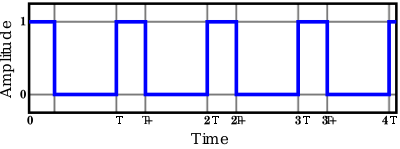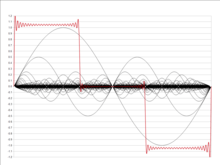Pulse wave


A pulse wave or pulse train is a kind of non-sinusoidal waveform that includes square waves (duty cycle of 50%) and similarly periodic but asymmetrical waves (duty cycles other than 50%). It is a term common to synthesizer programming, and is a typical waveform available on many synthesizers. The exact shape of the wave is determined by the duty cycle of the oscillator. In many synthesizers, the duty cycle can be modulated (sometimes called pulse-width modulation) for a more dynamic timbre.[1] The pulse wave is also known as the rectangular wave, the periodic version of the rectangular function.
The average level of a rectangular wave is also given by the duty cycle, therefore by varying the on and off periods and then averaging these said periods, it is possible to represent any value between the two limiting levels. This is the basis of pulse width modulation.
The Fourier series expansion for a rectangular pulse wave with period T and pulse time τ is
Note that, for symmetry, the starting time (t = 0) in this expansion is halfway through the first pulse. The phase can be offset to match the accompanying graph by replacing t with t - τ/2.
A pulse wave can be created by subtracting a sawtooth wave from a phase-shifted version of itself. If the sawtooth waves are bandlimited, the resulting pulse wave is bandlimited, too. Another way to create one is with a single ramp wave (sawtooth or triangle) and a comparator, with the ramp wave on one input, and a variable DC threshold on the other. The result will be a precisely controlled pulse width, but it will not be bandlimited.

The harmonic spectrum of a pulse wave is determined by the duty cycle.[2][3][4][5][6][7][8][9] Acoustically, the rectangular wave has been described variously as having a narrow[10]/thin[1][3][4][11][12], nasal[1][3][4][10]/buzzy[12]/biting[11], clear[2], resonant[2], rich[3][12], round[3][12] and bright[12] sound. Pulse waves are used in many Steve Winwood songs, such as "While You See a Chance".[10]
See also
References
- 1 2 3 Reid, Gordon (February 2000). "Synth Secrets: Modulation", SoundOnSound.com. Retrieved May 4, 2018.
- 1 2 3 Holmes, Thom (2015). Electronic and Experimental Music, p.230. Routledge. ISBN 9781317410232.
- 1 2 3 4 5 Souvignier, Todd (2003). Loops and Grooves, p.12. Hal Leonard. ISBN 9780634048135.
- 1 2 3 Cann, Simon (2011). How to Make a Noise, [unpaginated]. BookBaby. ISBN 9780955495540.
- ↑ Pejrolo, Andrea and Metcalfe, Scott B. (2017). Creating Sounds from Scratch, p.56. Oxford University Press. ISBN 9780199921881.
- ↑ Snoman, Rick (2013). Dance Music Manual, p.11. Taylor & Francis. ISBN 9781136115745.
- ↑ Skiadas, Christos H. and Skiadas, Charilaos; eds. (2017). Handbook of Applications of Chaos Theory, [unpaginated]. CRC Press. ISBN 9781315356549.
- ↑ "Electronic Music Interactive: 14. Square and Rectangle Waves", UOregon.edu.
- ↑ Hartmann, William M. (2004). Signals, Sound, and Sensation, p.109. Springer Science & Business Media. ISBN 9781563962837.
- 1 2 3 Kovarsky, Jerry (Jan 15, 2015). "Synth Soloing in the Style of Steve Winwood". KeyboardMag.com. Retrieved May 4, 2018.
- 1 2 Aikin, Jim (2004). Power Tools for Synthesizer Programming, p.55-56. Hal Leonard. ISBN 9781617745089.
- 1 2 3 4 5 Hurtig, Brent (1988). Synthesizer Basics, p.23. Hal Leonard. ISBN 9780881887143.